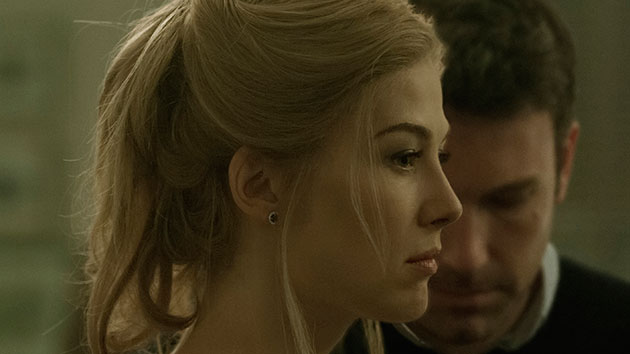For fans of state-of-the-art filmmaking craft, Gone Girl is the movie of the moment. Directed by David Fincher with his usual precision and economy, the film turns a best-selling page-turner into a riveting 149-minute exercise in style and tension. Here's a round-up of what we know about production and post on the film, drawn from StudioDaily and other sources around the web.
Photos by Merrick Morton
 Gone Girl was captured entirely in 6K with Red Dragon cameras, which recorded Redcode Raw footage to 256 GB Redmag SSDs. Cinematographer Jeff Cronenweth employed a set of Leica Summilux-C lenses provided by Otto Nemenz and worked with a lighting kit based on Kino Flos and tungsten globes. Dailies were reviewed in 4K on a 65-inch monitor via the Pix system. Source: HDVideoPro.com
Gone Girl was captured entirely in 6K with Red Dragon cameras, which recorded Redcode Raw footage to 256 GB Redmag SSDs. Cinematographer Jeff Cronenweth employed a set of Leica Summilux-C lenses provided by Otto Nemenz and worked with a lighting kit based on Kino Flos and tungsten globes. Dailies were reviewed in 4K on a 65-inch monitor via the Pix system. Source: HDVideoPro.com
When it comes to location, details count. After scouting around the film's Cape Girargeau, Missouri, location, Donald Graham Burt selected a house for Nick and Amy Dunne that would reveal facets of their characters and situation. "The house wan't too grand, yet it was large enough that two people could feel there was both closeness and at the same time a kind of separateness — the unspoken ‘don’t enter my space, I won’t enter yours.’ We wanted it to feel vacuous yet have layers. It evoked the feeling of a McMansion without being disturbingly vulgar. We liked that it had classical elements, so that some of the wood in the Carthage house echoes their more historical townhome in New York but in a skewed way. It’s as if the house yearns to be traditional … but the hardware and the light fixtures and the vinyl windows give it away.” Source: Studio press notes.
The shoot took around 110 days, and editor Kirk Baxter spent around 10 months in post, making the timeframe a little shorter than The Social Network. Notably, he was working for Fincher without regular co-editor Angus Wall this time around. What's Wall up to that he's too busy to hang with Baxter and Fincher? Word is he has been developing a project, Empire, to serve as his directorial debut.) Sources: Thompson on Hollywood; The Hollywood Reporter
Premiere Pro was selected as a way to give the project independence and save it money. Adobe seized on this aspect of the workflow, producing the following infomercial, which puts post houses and VFX notice that Fincher and Co. are bringing work in-house that used to get farmed out to third-party vendors.
Sources: StudioDaily; Adobe/YouTube
The post workflow, centered around Premiere as well as After Effects, was powered by an array of high-powered hardware from HP, Intel, Nvidia, and more. A new Nvidia Quadro K5200-accelerated Redline implementation from Red Digital Cinema was used for debayering. Source: StudioDaily; Nvidia Case Study
The "hero VFX workstation" for the project was HP's Z820, running Adobe After Effects CC and Premiere Pro CC with graphics acceleration via Nvidia's latest K5200 video hardware. That system output 4K over Thunderbolt 2 for VFX playback and review via a AJA's Io 4K device with no tearing or artifacts. VFX for Gone Girl included mostly performance retiming and recombination, split-screen comps, and optical effects. Source: AJA press release
Gone Girl is said to be the first studio feature edited from SSD-based shared storage. Provided by Open Drives, the system was required to take advantage of Premiere Pro's CUDA-accelerated performance–a single stream of 6K DPX footage requires 1.8 GB/sec of throughput, compared to a mere 800 MB/sec for 4K. Workstations were connected to the SSD array via Solarflare 10GbE adapters. Open Drives co-founder and CTO Jeff Brue gave an info-packed presentation on 6K workflow in a presentation at Nvidia's booth at SIGGRAPH, and you can scroll down to watch the whole thing. Here are the highlights, in case you don't have 10 minutes to spare.
| Storage System Specifications | |
|
Offline Volume Open Drives Velocity 36 TB SSD 60 TB hard drive Custom Premiere-accelerating caching volumes Six 10 GbE Solarflare ports |
Online Volume
Open Drives Aurora 320 TB 1 TB SSD cache Six 10 GbE Solarflare ports |
- Offline editorial took place at 2304×1152, allowing a 1920×800 center extraction that would correspond to an eventual 5K extraction (5120×2133) from the 6K frame (6144×3072). That allowed shots to be stabilized and reframed at will, with Premiere Pro repositioning the frame in real time. Because Premiere can export via Nvidia hardware at up to five times faster than real time, with eight editors on the show, some of them working in multicam, the offline editorial system was being taxed with throughput as high as 3.5 GB/sec.
- Third-party video hardware was eliminated from the offline workflow, mainly for the sake of simplicity. Having a third monitor output on Nvidia's K5000 hardware helped make that possible.
- Multiple FusionIO drives were employed to handle the data required for live flowthrough from After Effects to Premiere–1.8 GB/sec for playback. At one point, more than 80 percent of the clips on Gone Girl's Premiere Pro timeline were After Effects compositions.
Source: Open Drives CTO Jeff Brue/Nvidia
Crafts: Editing Post/Finishing Shooting VFX/Animation
Sections: Technology
Topics: adobe After Effects AJA david fincher fusionio gone girl hp io 4k jeff cronenweth kirk baxter NVIDIA open drives pix system premiere pro red dragon studiodaily dossier
Did you enjoy this article? Sign up to receive the StudioDaily Fix eletter containing the latest stories, including news, videos, interviews, reviews and more.











Meh I can’t stand Premiere personally and I use it every day. I just need a few days off to make the switch back to FCPX.